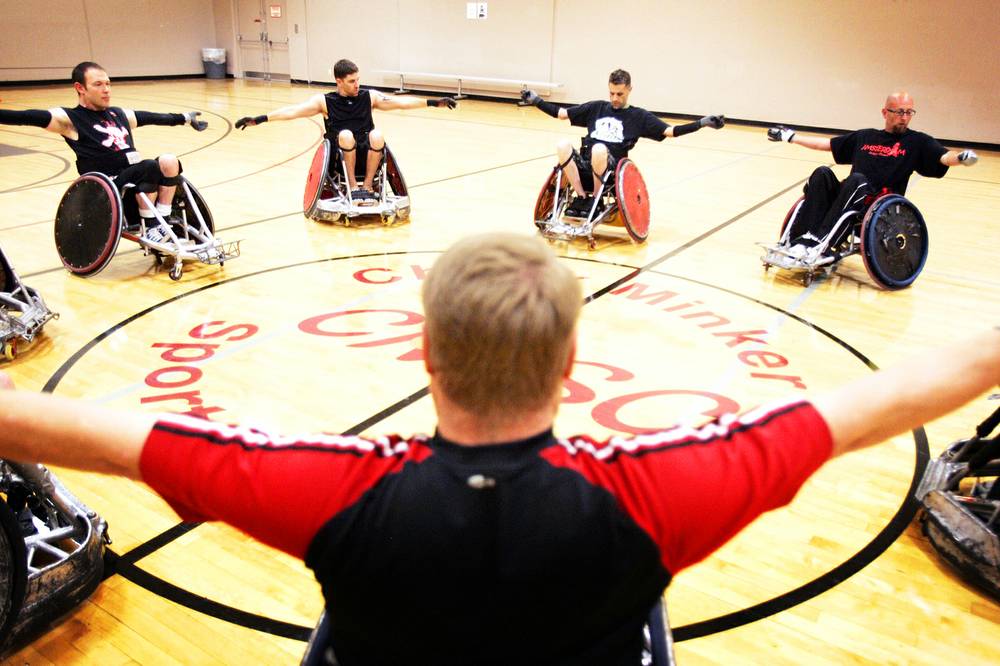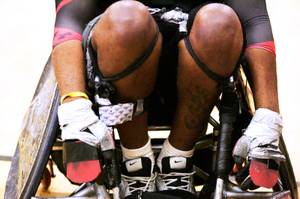Some know it as murderball, a cheeky nickname officials downplay because most corporate sponsors steer clear of things even remotely suggesting murder. That’s also the title of the critically acclaimed 2005 documentary on the sport, which officially goes by the title quadriplegic rugby in the U.S., or quad rugby. Worldwide it’s known as wheelchair rugby.
Whatever its name, the sport is brutal. Any of the players will tell you that. So will the unmistakable bang of metal-on-metal that echoes through the basketball court and down the halls of the community center during this Monday night practice session for Vegas-based team Sin City Skulls. It sounds like bumper cars, and essentially it is.
Players like Michael Schacherbauer propel themselves down the court at full speed into the front of opponents’ chairs. The force of the impact is so strong, sometimes the wheelchairs pop off the ground, suspended in the air for just a moment. They brace their wheels against one another; the friction can be enough to slow or stop a rival from advancing.
This is a full-contact sport, though players aren’t allowed to touch each other. Contact with another person’s body results in time spent in the penalty box. The contact is reserved for the specially designed wheelchairs, and the damage shows on them. Schacherbauer’s chair, like everyone else’s, has been beaten and battered, scrapes and scratches cover its entire base like the grungiest of amusement park vessels ready for retirement.
His chair is only six months old, and as far as Schacherbauer is concerned, equipment is key. “You’re only as good as your equipment will let you be,” he explains. “It’s like golf.”
Details
- To donate, go to sincityskulls.com.
Violent golf on wheels? Not really. Typically, the sport is described as a mesh of volleyball, basketball and hockey. It’s Canadian born, made especially for quadriplegics or individuals with impaired motor skills in at least three of four limbs. Players must be able to push themselves on their own, though their skills beyond that vary.
To balance out a game whose players have such a wide range of physical abilities, the U.S. Quad Rugby Association ranks each player on a scale from 0.5 to 3.5—the less extensive your quadriplegia, the lower your number. Schacherbauer, for example, a spinal cord injury victim, comes in at a 2.0, while Lee Browning, a longtime Vegas player that suffers from a genetic disorder called ataxia, is a 0.5.
The four team members on the court at any given time cannot have a combined ranking of more than eight points, meaning for every 3.5, you essentially need a .5. “It creates a balance and makes everyone needed,” says Browning.
The game itself is simple enough: Two teams of four players score points by carrying a volleyball through goals set up at either end of a regulation-sized basketball court. They must adhere to rules about the number of players inside the goal area, making sure the ball is thrown or bounced every 10 seconds and not fouling one another by touching another player’s arms or legs. Games have four eight-minute quarters.
“In every other sport we are second-rate,” reasons Skulls team captain CJ Arinwine. “This sport is the only one created specifically for us. You can take an able-bodied person, put them into a chair and they might not be able to keep up. They don’t have the upper body strength. Or the endurance—a lot of this is about endurance.”
That’s something these men—and the Skulls’ one female player—know a lot about, on and off the court. The Skulls’ team consists of players with, among other things, muscular dystrophy, spinal cord injuries and even burns. Some have been dealing with disabilities for only a few years. Others have spent their entire lives in chairs.
Even with their varying backgrounds, their unified quad status means they can all relate to—and grow off—one another. For some, that’s just as valuable as the physical benefits the game has for its players.
Browning’s mother, Sue, says she could see the change in her son after he became involved in quad rugby. He was happier, more confident and in better physical shape—all because he had a physical outlet, something Browning lacked since his ataxia progressed to the point he could no longer play mainstream sports or drum, as he had as a child.
“If you can play sports, it usually means that the rest of your life is together,” says Schacherbauer, who is currently a student. “You see people with drug or psych issues, but not usually on a team like this. To play this kind of game and put yourself through this, you have to really be here and committed.”
For the Skulls, commitment includes more than tonight’s grueling two-and-a-half hour practice prepping them for a second consecutive run in the national tournament being held this week. It involves a lot of out-of-pocket expenses. Just to start, quad rugby chairs cost upwards of $5,000, not including the wheels. Maintenance isn’t cheap, either. Then there’s the cost of travel (doubled, usually, since most players cannot travel alone) and registration fees for tournaments.
Originally, the five-year-old Skulls had free weekly practice space and help planning tournaments from the county government, but financial cutbacks have hit hard. A benefactor currently helps them pay for gym space, but those funds might stop coming in before the next quad rugby season, which runs from September to April.
The Skulls created a nonprofit in an attempt to raise the much-needed money for the team. Travel expenses and rental space are priorities, but Browning has high hopes that the team might get some simpler pleasures, too. The numbers on the team’s original jerseys are fading. They need new ones. And you’d be hard-pressed to say they haven’t earned them.









Previous Discussion: